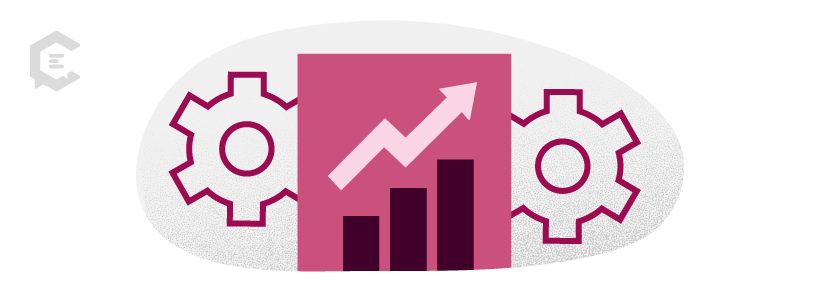When asked, “How are your New Year’s resolutions coming?” the cynic in us would say, “Give it a month or two, then watch them fizzle into oblivion.”
While that, unfortunately, maybe the case with a good number of personal resolutions as the year wears on, in business, setting sound marketing goals — and following through — is a primary ingredient for success.
But with the marketing landscape becoming more competitive and dynamic, equally as important as setting goals and sticking to them is the ability to pivot as the need arises.
In this blog post, we’ll cover:
- The importance of regularly refining marketing goals
- How to assess performance against goals
- Some techniques for refining marketing goals
- Best practices for continuous goal improvement
- How to integrate feedback loops into your marketing strategy

The Importance of Regular Goal Evaluation
Times change. Technologies come and go. Markets ebb and flow. User behaviors evolve — and so do marketing goals. In fact, approximately 50 percent of marketers saw their marketing goals change in 2023.
But why should you regularly revisit your marketing goals? The reasons are many:
- Flexibility: Adapt swiftly to changing market conditions. Adjust strategies in response to emerging trends and shifts in consumer behavior.
- Better resource allocation: Maximize the impact of your marketing efforts. Reallocate budgets, time, and personnel to campaigns or initiatives that prove the most effective.
- Performance optimization: Understand what works best. Then, optimize your content marketing and other strategies to improve overall results.
- Improved decision-making: Make data-driven adjustments promptly. Ensure campaigns align with organizational objectives.
- Enhanced accountability: Cultivate a results-oriented environment. Motivate teams to meet and exceed targets by keeping them apprised of individual and team progress.
- Increased innovation: Encourage teams to experiment and push the boundaries of conventional strategies to find new and effective solutions.
- Better customer experience: Stay in tune with evolving consumer needs and preferences. Refine marketing campaigns to better resonate with target audiences.
- Competitive advantage: Stay ahead of competitors, particularly in rapidly changing industries, such as finance, healthcare, retail, automotive, and telecom.
Assessing Marketing Goal Performance
To adapt your marketing goals — whether to focus more on campaigns that are working or maintain your edge in an increasingly competitive business landscape — the first step is to know how you’re performing against current goals.
Are you hitting targets? Are you falling behind? What are your strengths and weaknesses? How are customers responding to your marketing messaging? So many questions, and it’s crucial that you have the right data to inform your decisions.
That’s where key performance indicators (KPIs) and analytics tools come in.

Identify KPIs
Marketing KPIs, in a nutshell, are metrics organizations put in place to track progress toward specific goals. They provide a snapshot of your initiatives’ performance so you can make data-driven decisions and refine your strategies accordingly.
Some of the most commonly used marketing KPIs include:
- Conversion rate: The percentage of website visitors completing a desired action, such as filling out a form, signing up for a free trial, or making a purchase
- Cost per lead (CPL): The cost of acquiring a new marketing lead
- Website traffic: The number of visitors a website generates over a specific period
- Social likes, shares, and comments: Audience interaction on social media posts, indicating the level of engagement
- Social media impressions: The number of times a social media post appears on a user’s device, which represents the post’s potential reach
- Email open rate: The percentage of recipients opening an email
- Content pageviews: The number of views a piece of content generates
- Marketing qualified leads (MQLs): Leads that are more likely to become customers based on their engagement with marketing activities
- Customer lifetime value (CLV): The total revenue expected from a customer throughout their entire relationship with a business
Remember that the KPIs you choose must align with overall objectives to ensure you’re tracking and measuring what truly matters. For example, if your goal is to increase revenue, your KPIs may include metrics related to customer acquisition, sales performance, and lifetime value.
Use analytics and reporting tools
To more accurately evaluate marketing performance via KPIs, you’ll need analytics and reporting tools. These provide the data necessary to help you identify the next steps. Some examples:
- Google Analytics: Tracks website traffic and user behavior. Use it to measure KPIs such as website visits, pageviews, bounce rates, and conversion rates
- HubSpot Analytics: Provides analytics for inbound marketing, sales, and customer service. Use it to pinpoint top-performing assets, check website performance, and access disparate reports in one central dashboard
- Facebook Insights: Monitors post performance on Facebook business pages and tracks user behavior. Use it to measure KPIs such as engagement and post reach, as well as understand audience demographics and preferences to tailor future content and advertising campaigns
- Google Ads reports: Analyzes the performance of Google Ads (formerly AdWords) campaigns. Use it to measure paid advertising KPIs, such as click-through rate (CTR) and cost per click (CPC)
- Mailchimp Analytics: Provides insights into the performance of email campaigns. Use it to evaluate email marketing KPIs such as open rate, subscriber growth rate, and unsubscribe rate. Then, perform A/B testing on content to improve results
- Salesforce reports: A customer relationship management (CRM) platform with powerful reporting capabilities. Use it to track KPIs related to sales funnel progression and customer retention
- SEMrush: A search engine optimization (SEO) tool that provides features such as keyword research, competitor analysis, and content optimization. Use it to evaluate organic search performance and identify opportunities to improve search engine ranking
Techniques for Refining Marketing Goals
Adjusting marketing goals is a highly involved process that combines several key factors, including strategic analysis, data-driven insights, and feedback mechanisms. Two of the most common techniques marketing teams employ to refine their goals include:

Data-driven goal adjustment
Leverage the data you have at your fingertips about marketing performance to inform your goal adjustment decisions — for example, where to allocate more resources or which campaigns to optimize.
Additionally, use predictive analytics to forecast future trends and identify potential challenge areas. Adjust marketing goals based on these predictions to stay ahead of the curve.
Responding to market changes and feedback
Paying close attention to market changes and customer feedback allows you to adjust your goals to take advantage of opportunities, address challenges, highlight strengths, and enhance overall customer satisfaction. This means:
- Staying on top of emerging trends that may impact your industry: If a particular technology gains massive adoption, such as generative AI, evaluate its relevance to your strategies
- Keeping a close eye on your competitors’ initiatives: Check how they’re responding to market changes and their successes and failures. This allows you insights into what’s working and what’s not
- Performing customer sentiment analysis: Monitor customer feedback on social media. Survey your customers and analyze their direct interactions with your company. This can help you understand how they perceive your brand and offerings
Best Practices for Continuous Goal Improvement
Goal setting is a dynamic, ongoing process rather than a static, one-time activity. It takes collective effort not only to establish ambitious but realistic goals but also to sustain continuous goal improvement.

Fostering a culture of agility and adaptability
Some best practices to consider:
- Embrace agile marketing: This marketing approach emphasizes iterative processes, collaboration, and quick strategy adjustments based on real-time feedback and data
- Prioritize learning and development: Invest in employee skill enhancement. Equip employees with the skills they need to navigate emerging trends and technologies
- Establish cross-functional collaboration: Break down departmental silos to bring diverse perspectives and insights into your goal refinement discussions. Encourage collaboration between different teams, including marketing, sales, and product development
Engaging teams in the refinement process
To encourage teams to participate:
- Promote transparent communication: Share insights gleaned from data analysis, market research, and customer feedback. Acknowledge the challenges to be hurdled, and ask team members to share their input
- Conduct regular strategy reviews: Schedule regular strategy sessions to assess marketing goals and initiatives, identify areas for improvement, and adjust goals as necessary
- Encourage experimentation: Implement pilot programs, A/B testing, and content format experiments to gain valuable real-world insights that can be pivotal in the goal refinement process
- Recognize and celebrate progress: Acknowledge both individual and team achievements. Show teams the impact of their contributions, and they’ll be more likely to participate

Integrating Feedback Loops Into Your Marketing Strategy
Feedback loops are a core component of marketing goal setting and refinement. Among other things, they:
- Provide a deeper understanding of customer needs, expectations, and preferences
- Allow teams to assess marketing effectiveness
- Enable continuous improvement through iterative adjustments
- Help identify opportunities and threats, so your team can capitalize on trends and mitigate risks before they become full-blown problems
- Manage brand perception and reputation
- Provide the data needed to make decisions based on hard evidence instead of assumptions
Examples of feedback mechanisms you can use:
Customer feedback and market research
These can include:
- Customer surveys: Obtain customer feedback regarding products, services, and overall brand experiences
- Social media listening: Analyze conversations about your brand. Use tools to monitor customer sentiment, preferences, and concerns
- Online reviews and ratings: Customer ratings and reviews provide a window into your customers’ concerns, which can help you create better marketing messaging and product positioning strategies
- User behavior analysis: Track how users behave on your various digital platforms, such as your website or app, so you can better optimize user experiences
- Market research and trend analysis: Identify trends, behavioral shifts, and competitor strategies to remain on the cutting edge
Internal feedback mechanisms
Interdepartmental collaboration, post-campaign reviews, and regular brainstorming sessions — these are necessary tools to leverage if you want a goal refinement strategy that:
- Ensures a complete understanding of the customer journey
- Pinpoints which initiatives work and which need revisiting
- Cultivates a culture of continuous improvement

Continuous Marketing Goal Refinement for Optimal Performance
Today’s business landscape is ever-evolving, and continuously refining your marketing goals is necessary to squeeze the most value out of your campaigns. By leveraging data-driven insights, integrating real-world feedback, and encouraging active participation in the goal refinement process, you’re in a much better position to seize opportunities as they emerge and deliver consistent value to the audiences you serve.
Need help crafting a content strategy that considers changing user expectations and market dynamics? Speak with an expert content strategist today.



